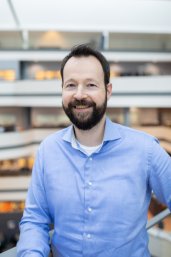Bert Janssen appointed Professor of Structural Cell Biology
Group visualizes interactions between cells
Utrecht University has appointed Bert Janssen as Professor of Structural Cell Biology. Janssen and his team use and develop techniques to visualize interactions between cells in great detail. As these interactions play a critical role in the optimal functioning of our tissues, gaining new insights into them could potentially pave the way for more effective treatments of, for example, cancer and diseases of the nervous system, such as multiple sclerosis.

Diseases
Cells within our bodies interact with each other via proteins on their surfaces. The precise structure of these proteins is crucial in this context, as it determines, amongst other things, how specifically proteins bind to other molecules. Cells interact with each other to exchange information, such as in our immune system or nervous system, and to form tissues, groups of cells that work together.
When cellular interactions misfunction, this may lead to diseases. For instance, in metastatic cancer, the mechanisms that normally keep cancer cells together are disrupted, leading to their detachment and spread throughout the body.
In their natural context
Over the past decade, Janssen has been using an array of techniques from the field of structural biology, which studies the structure of large biological molecules, to precisely unravel the composition of cell surface proteins and how they form complexes with other molecules. However, until now, these methods have required the purification of the proteins, which resulted in the examination of the proteins outside their natural environment.
We need many small successes to get there, but ultimately our goal is to visualize cell interactions within tissues, their natural environment.
This offers an incomplete understanding of the true complexity. Janssen: "When two cells are close together, all kinds of things are happening that affect the processes we are investigating. Therefore, it is important to include that context."
The next step
According to Janssen, the time has come to take the next step. Janssen: "Ultimately, our goal is to visualize cell interactions within tissues, their natural environment. Emerging techniques provide avenues to achieve this. We have not reached this point yet and we need many small successes to get there, but we want to take that step forward."
Janssen highlights that he significantly benefits from collaborating with Utrecht colleagues who possess expertise in different areas. Among other things, it helps him build expertise in new areas. One example is cryo electron tomography, a technique enabling the creation of highly detailed three-dimensional images of proteins using frozen samples and electron microscopy.
Intermediate step
Until interactions can be directly imaged within tissues, Janssen employs an intermediary approach: a model system. Janssen explains: "We recreate the outer surfaces of cells, the cell membranes, and then affix the proteins we wish to investigate onto them. So we add protein one on one membrane, and protein two on the other membrane. Because you know exactly what you have added yourself, you know what you are looking at. This simplifies the process substantially. In real interactions between cells, hundreds of proteins are involved, which makes it challenging to visualize the specific proteins of interest."
It is important to combine and share the knowledge that we possess within our group.
Fundamental in nature
The research of Janssen and his team is fundamental in nature, oriented towards comprehending the mechanisms underlying interactions between cells. However, Janssen carefully selects the topics he investigates. Janssen: "I primarily concentrate on processes known to play a role in diseases, but for which a good understanding of exactly how those processes work is lacking. Understanding them would enable better and more efficient interventions."
Janssen experienced firsthand how his fundamental research can ultimately translate into drug applications. Janssen: "Seventeen years ago, I worked on a project without knowing if it would be useful. Just two years ago, a medicine was introduced to the market for an eye disorder and blood disease, that uses the insights I had gained during that time. So it may take some time, but eventually, you end up having a direct impact."
More than research
Janssen emphasizes that scientists do more than just research. Education, for one, also plays a significant role. Presently, Janssen and his colleagues are actively involved in creating a new course within the bachelor's programme of Chemistry. Moreover, the group also contributes to the bachelor's programme Molecular and Biophysical Life Sciences as well as the master's programme Molecular and Cellular Life Sciences. Janssen: "It is important to combine and share the knowledge that we possess within our group."
Furthermore, Janssen is committed to unifying his research field in the Netherlands. Janssen: "I have pushed for setting up a platform for collaboration, the Structural Biology Platform, to, for example, facilitate discussions and the sharing of equipment."
Janssen has also contributed to the increased visibility of younger group leaders within Utrecht University's Life Sciences strategic theme. Janssen: "The strategic theme is so big that it is often not in the line of sight of younger group leaders, and younger group leaders are not in the picture within the theme. I have been striving to give these group leaders a voice and bring them together."

